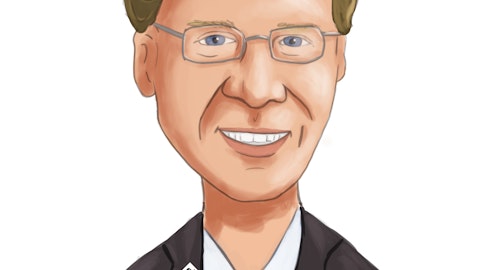Sandy Spring Bancorp, Inc. (NASDAQ:SASR) Q3 2023 Earnings Call Transcript October 24, 2023
Sandy Spring Bancorp, Inc. beats earnings expectations. Reported EPS is $0.62, expectations were $0.56.
Operator: Hello, and welcome to today’s Sandy Spring Bancorp, Inc. Earnings Conference Call and Webcast for the Third Quarter. My name is Jordan and I’ll be coordinating your call today. [Operator Instructions] I’m now going to hand over to Dan J. Schrider, President and CEO to begin. Dan, please go ahead.
Daniel Schrider: Thank you and good afternoon, everyone and thank you for joining our call to discuss Sandy Spring Bancorp’s performance for the third quarter of 2023. This is Dan Schrider and I’m joined here by my colleagues Phil Mantua, Chief Financial Officer; and Aaron Kaslow, our General Counsel and Chief Administrative Officer. Our today’s call is open to all investors, analysts and the media. There is a live webcast of today’s call, and a replay will be available on our website later today. Before we get started covering highlights from the quarter and then moving to your questions, Aaron will give the customary Safe Harbor statement.

A bank manager standing next to a full-service branch counter, representing traditional banking activities. Editorial photo for a financial news article. 8k. –ar 16:9
Aaron Kaslow: Thank you, Dan. Good afternoon, everyone. Sandy Spring Bancorp will make forward-looking statements in this webcast that are subject to risks and uncertainties. These forward-looking statements include statements of goals, intentions, earnings and other expectations, estimates of risks and future costs and benefits, assessments of expected credit losses, assessments of market risk and statements of the ability to achieve financial and other goals. These forward-looking statements are subject to significant uncertainties because they are based upon or affected by management’s estimates and projections of future interest rates, market behavior, other economic conditions, future laws and regulations and a variety of other matters, which by their very nature, are subject to significant uncertainties.
Because of these uncertainties, Sandy Spring Bancorp’s actual future results may differ materially from those indicated. In addition, the Company’s past results of operations do not necessarily indicate its future results.
Daniel Schrider: Thanks Aaron. When we spoke with you last quarter we underscored that some of our most pressing priorities included growing core funding, improving liquidity and expanding our client base. And I’m pleased to report today that we’re showing impressive results on all those fronts. These gains are not only important to our performance today, but they pave a way for us to continue to deepen and expand our client base in the future. We’re also moving the needle on key metrics, such as reducing our loan to deposit ratio and commercial real estate concentration as well as our reliance on noncore funding. And additionally, our credit quality remains very strong as we enter the season of greater economic uncertainty.
See also Top 10 Oil and Gas Stocks To Buy and 12 Biggest Energy Drink Stocks in the US.
Q&A Session
Follow Sandy Spring Bancorp Inc (NASDAQ:SASR)
Follow Sandy Spring Bancorp Inc (NASDAQ:SASR)
And to add to this momentum, we are preparing to launch this month a more sophisticated, secure and user-friendly digital banking platform. This platform will give our clients more control and make it easier for them to bank when and how they want to bank with us. This enhancement comes on the heels of an improved online account opening platform that we launched just six months ago. Between our highly competitive products, talented bankers and now seamless account opening process, we achieved over 1% client based growth this quarter, representing over 1500 new clients to our bank. So we’re already gaining traction and seeing results and we’re confident these investments will continue to unlock additional growth opportunities for us. So with that, let us review our third quarter financial results.
Today, we reported net income of $20.7 million or $0.46 per diluted common share for the quarter ended September 30, compared to net income of $24.7 or $0.55 per diluted common share for the second quarter and $33.6 million or $0.75 per diluted common share for the third quarter of 2022. The decline in the current quarter’s net income compared to the linked quarter was the result of the one-time pension settlement expense associated with the previously disclosed termination of the company’s pension plan, coupled with lower net interest income. Current quarter core earnings were $27.8 million or $0.62 per diluted common share compared to $27.1 million or $0.60 per diluted common share for the previous quarter and $35.7 million or $0.80 per diluted common share for the quarter ended September 30, 2022.
The increase in core earnings compared to the previous quarter was a result of the lower provision for credit losses, lower salaries and employee benefit expense and lower marketing expenses, offset by reduced net interest income. The provision for credit loss is directly attributable to funded loan portfolio for the current quarter was $3.2 million compared to $4.5 million in the prior quarter and $14.1 million in the prior year quarter. This quarter’s provision was primarily the result of increases in individual reserves on a few commercial lending relationships which were partially offset by a qualitative adjustment related to the reduced probability of recession. Additionally, during the current quarter, the company reduced its reserve for unfunded commitments by $800,000 as a result of higher utilization of lines of credit.
Shifting to the balance sheet, total assets remained stable at $14.1 billion compared to $14 billion at June 30. Total loans declined by $69.3 million or 1% to $11.3 billion at September 30, compared to $11.4 billion at June 30, 2023. Total commercial real estate and business loans declined $79.2 million quarter-over-quarter due to a $107 million or 10% decline in the ADC portfolios. Investor and owner occupied commercial real estate loan portfolios remain relatively unchanged and commercial business loans and lines increased $31.1 million or 2%. Residential mortgage loans grew $16 million or 1%, mainly due to the migration of construction loans into the permanent residential mortgage portfolio. Overall, the loan portfolio mix remained relatively unchanged compared to the previous quarter.
Commercial loan production totaled $323 million, yielding $96 million in funded production. This compared to commercial loan production of $313 million yielding $160 million in funded production in the second quarter of the year. Given softer loan demand as a result of both the rate and economic environment, we expect funded loan production to fall between $100 million and $200 million per quarter over the next couple quarters. While we continue to focus on the deposit acquisition and retention side, we’re closely monitoring loan demand and core deposit growth to determine the appropriate level of funded loan activity. Pages 22 through 24 of our supplemental deck provide more detail on the composition of our loan portfolios, the granularity on our commercial real estate portfolio and specific commercial real estate composition in the urban markets of DC and Baltimore.
Shifting to deposits, total deposits increased $192.1 million or 2% to $11.2 billion compared to $11 billion at June 30. During this period, total interest bearing deposits increased $258.1 million or 3% while noninterest bearing deposits declined $66 million or 2%. Growth in interest bearing deposit categories was driven by savings accounts and core time deposits, which increased by $277.4 million and $263.7 million respectively. These increases were partially offset by the $155.8 million decrease in broker time deposits as we reduced our reliance on wholesale funding sources and the $177.5 million decrease in money market accounts. So excluding broker deposits, total deposits increased $349.5 million or 4% quarter-over-quarter and represented 90% of total deposits compared to 88% in the linked quarter, reflecting the continued stability of the core deposit base.
The deposit growth during the quarter resulted in the loan to deposit ratio declining to 101% at September 30 from 104% at June 30, 2023. Total uninsured deposits at September 30 were approximately 33% of total deposits. As I’ve shared in prior quarters, we continue to offer our customers reciprocal deposit arrangements, which provide FDIC deposit insurance for accounts that would otherwise exceed deposit insurance limits. During the quarter ended September 30, 2023, balances in the company’s reciprocal deposit accounts increased by $131.6 million. Slide 17 of the supplemental deck provides more color on our commercial deposit portfolio, which represents 58% of total core deposits, the majority of which is in a combination of noninterest bearing and money market accounts.
With an average length of relationship of 9.5 years, the portfolio is well diversified with no concentration in a single industry or single client. Likewise, on Slide 19 of the supplemental deck, you can see the breakdown of our retail deposit book. With an average length of 11.5 years the retail deposit portfolio represents 42% of our core deposit base with no single client accounting for more than 2% of total deposits. Total borrowings declined by $57.8 million or 4% at September 30 compared to the previous quarter, driven by a $50 million reduction in FHLB advances. The outstanding balance of borrowings through the Fed’s bank term funding program remained unchanged at $300 million at quarter end. At September 30, contingent liquidity, which consists of available FHLB borrowings, Fed funds, funds through the Bank Term Funding program, as well as excess cash and unpledged investment securities, totaled $6.1 billion or 168% of uninsured deposits.
At September 30, total cash and cash equivalents were $717.6 million, an increase of $287.5 million or 67% compared to the linked quarter, primarily result of the strong deposit growth I mentioned earlier. Noninterest income for the third quarter of 2023 increased by 1% or $200,000 compared to the linked quarter and grew by 3% or $0.5 million compared to the prior year quarter. The current quarter’s increase was driven by higher wealth management income and higher lending related fees and was partially offset by lower BOLI income due to mortality proceeds received in the second quarter. Income from mortgage banking activities decreased $135,000 compared to the linked quarter and total mortgage loans grew $47 million. Future levels of mortgage gain revenue is expected to fall between $1 million and $1.5 million in the fourth and first quarters.
Wealth management income increased $360,000 to $9.4 million and assets under management at quarter end totaled $5.6 billion representing a 3% decrease since June 30. For the third quarter of 2023 the net interest margin was 255 compared to 273 for the second quarter of 2023 and 353 for the third quarter of 2022. As we shared last quarter, the margin continues to be impacted by high market rates, fierce deposit competition and clients moving excess funds out of noninterest bearing accounts. Compared to the linked quarter, the rate paid on interest bearing liabilities were 36 basis points, while the yield on interest earning assets increased 8 basis points, resulting in a quarterly margin compression of 18 basis points. The margin for the month of September came in at 2.5%.




